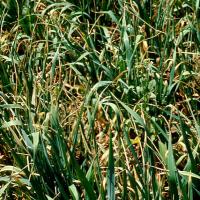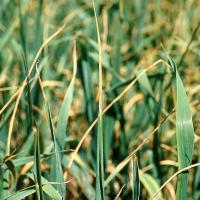Diagnosing copper deficiency in oats
Most soils in Western Australia were copper deficient in their natural state. Copper is essential for pollen formation and has a role in formation of chlorophyll and lignification (cell wall strength). Deficiency causes sterile pollen, which, in turn causes poor grain formation and high yield losses.
Oats are less susceptible to copper deficiency when compared to wheat and barley.
What to look for
- Before head emergence deficiency shows as areas of pale, wilted plants with dying new leaves in an otherwise green healthy crop.
- After head emergence few grains are set and plants become discoloured and mature later.
- Symptoms are often worse on sandy or gravelly soils, where root pruning herbicides have been applied and recently limed paddocks
Paddock
- Youngest growth is affected first.
- Young leaves turn pale green and wilted, then die back from the tip. Dead tissue usually rolls or twists into a tight tube or spiral.
- Old leaves remain green, but paler than normal
- Tiller production before flowering is often unaffected but they may die prematurely. after flowering, very late tillers often appear.
Plant
What else could it be
| Condition | Similarities | Differences |
|---|---|---|
| Diagnosing stem and head frost damage in cereals | Aborted seed | Rarely affects the whole panicle, plants are not discoloured or produce late tillers. |
Where does it occur?

Soil type

Dry conditions

Spraying herbicide
- Most sandy surfaced soils required copper and zinc when initially cleared for agriculture
- Copper is relatively immobile in soil and can become unavailable to crops in dry soil.
- Where copper soil levels are marginal, deficiency can be induced by applications of lime, increased nitrogen fertiliser and zinc fertiliser
- The use of root-pruning herbicides, particularly groups A and B can induce copper deficiency
Management strategies

Spraying foliar
- Foliar spray (only effective in the current season) or drilled soil fertiliser
- Copper foliar sprays are not effective after flowering as sufficient copper is required pre-flowering for pollen development
- Mixing copper throughout the topsoil improves availability due to more uniform nutrient distribution
- As copper is immobile in the soil topdressing is ineffective, only being available to the plant when the topsoil is wet
- In long term no-till paddocks frequent small applications of copper via drilled or in-furrow application reduces the risk of plant roots not being able to obtain the nutrient in dry seasons
- Copper drilled deep increases the chances of roots being able to obtain enough copper when the topsoil is dry
- Copper seed treatment is insufficient to for plant requirement in the current season.
- Applying 3 to 9 kg/ha of copper sulphate (25% Cu) with fertiliser at seeding in areas suspected to be deficient in Cu correct the deficiency. Copper fertiliser has a long residual in the soil, and a single Cu application at recommended rates can last 20-30 years
How can it be monitored?

Tissue test


Tissue test
- A DTPA soil test is not sufficiently calibrated and provides at best a rough guide to soil copper status
- Whole-top plant test provides a rough guide if paired good/ poor samples are taken, but this should be confirmed with a youngest emerged blade (YEB) test.
- YEB levels below 1.5 mg/kg indicate copper deficiency.
- Copper deficiency may be confirmed by submitting samples of affected heads containing grain and unaffected heads for grain analysis
- Grain levels below 1.2 mg/kg indicate copper deficiency
Where to go for expert help
Page last updated: Wednesday, 1 July 2015 - 11:27am



